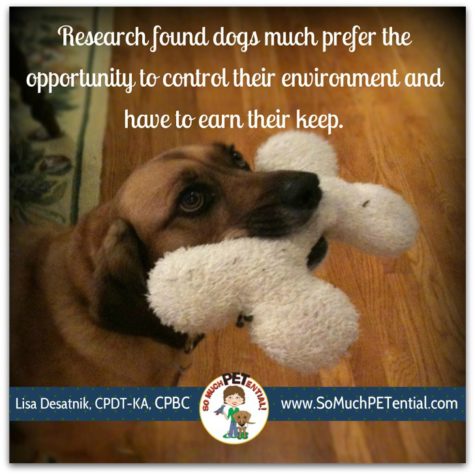Have you ever had an Aha Moment? Also known as a Eureka Moment, it is that incredible feeling you get from deep inside when a life event gives you clarity, or when suddenly you understand a previously incomprehensible problem or concept. To everyone who has experienced it, you know how profoundly that moment can change your day…or even your life.
 Now think about how you typically feed your dog his meals. More than likely, you feed your pet at least some – if not all – of his meals in a bowl on the floor. Yes, I know, you are probably thinking right about now what an Aha Moment could possibly have to do with how you feed your dog, and why that matters. Well, I’ll explain.
Now think about how you typically feed your dog his meals. More than likely, you feed your pet at least some – if not all – of his meals in a bowl on the floor. Yes, I know, you are probably thinking right about now what an Aha Moment could possibly have to do with how you feed your dog, and why that matters. Well, I’ll explain.
Researchers in Sweden recently investigated which a dog prefers – an easy paycheck or one that requires him to problem solve to achieve. Guess what they learned? Yep, dogs much prefer the opportunity to control their environment and have to earn their keep.
About the study
The research looked at six matched pairs of beagles who were taught how to manipulate three of six pieces of equipment in a room. Their success was marked with a distinct sound and followed by a treat.
A week after their training sessions, the dogs were tested in a new environment. Each dog was an experimental dog for half the time and a control dog for the other half. The testing room included a start arena with all six pieces of equipment and a gate leading to a runway that led to the reward. After leading the experimental dog into the room, an assistant turned away offering no additional interaction. When the dog did the behavior it was previously taught to do, the gate opened which gave access to the ramp leading to the reward. With the control dogs, the gate was opened after the length of time it had taken for the experimental dog to solve the puzzle, so the dog spent the exact amount of time in the room as its pair. The only difference between the two conditions was whether or not the gate opening was contingent on the manipulation of the equipment.
Among the findings
Interestingly, dogs were quick to enter the test room initially but the control dogs became increasingly reluctant. By the end of the test sessions, the control dogs even had to be coaxed from a handler to enter the area. Also dogs acting as controls were observed to chew on the operant device on several occasions, but not when acting as experimental animals. That chewing tended to occur more toward the end of the study during the last matched pair of testing after they had already served as the experimental animals three times. Researchers hypothesized this behavior may have been caused by frustration because no longer did manipulation of the equipment (a behavior that had in the past resulted in a valued positive reinforcement consequence) lead to the door opening.
Experimental dogs were more active in the start arena than control dogs despite the fact that the dogs had equal knowledge of the reward at the end of the runway and thus should have shown similar levels of anticipatory excitement. In other words, “the dogs were experiencing a learning process that they did not experience when they were acting as controls.”
Also, researchers found that experimental dogs wagged their tails more. More than that, researchers found the dogs wagged their tails more when expecting a food reward or contact with a human and less when expecting contact with another dog. (Keep in mind, these dogs were never deprived of contact with other dogs, but they did not receive treat items regularly and they received less human contact than other dog contact. All of these motivating operations may have contributed to where the dogs had the greatest value.)
Their scientific conclusion
“The experimental animals in our study were excited not only by the expectation of a reward, but also about realizing that they themselves could control their access to the reward. These results support the idea that opportunities to solve problems, make decisions, and exercise cognitive skills are important to an animal’s emotional experiences and ultimately, its welfare.”
What is the take home lesson for you?
When we bring animals into our homes, we need to remember that enrichment is such an important piece of setting ourselves, our pets, and our relationship up for success. Providing our pets with opportunities to problem solve, exercise their minds and bodies, and use their senses allows them to expend energy they need to use in positive ways and also adds to their quality of life.
And, I don’t know about you, but I happen to love seeing our Sam’s tail wag.
Always remember…be creative AND have fun!
I’d love to hear from you your ideas of how you engage your pet in active learning.








